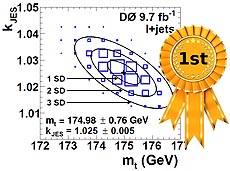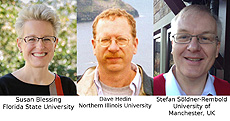Most precise single measurement of the top quark mass
 |
| The DZero experiment this week released the single most precise measurement of the top quark mass ever made. This plot shows the favored region for the top mass (the x-axis) and an important experimental parameter kJES (the y-axis) which is extracted simultaneously to improve the overall precision. |
Disponible en español
Just four weeks ago in this column we featured the world combination of top quark mass measurements, which used as ingredients the set of best measurements from both Tevatron and LHC experiments available in February 2014. Far from indicating that we've reached the end of top quark analyses at DZero and CDF, this represents just a single snapshot of a continually developing program. As a perfect illustration, the DZero experiment this week released a new measurement of the top quark mass in the lepton-plus-jets channel, which is the most precise single measurement ever made and which is actually competitive with the world average itself.
The lepton-plus-jets channel is probably familiar to regular readers. The analysis reconstructs top quark-antiquark pairs in their decays into four quark jets, a charged lepton (an electron or muon) and missing momentum consistent with an undetected neutrino. This signature is distinctive enough to be distinguished from most backgrounds, but it also provides a sufficiently large sample with which to reach the required statistical precision on the top mass. Effectively, once the sample composition has been determined, the mass of the top (or antitop) quark can be extracted by appropriately adding the energies of the six decay products, which of course is much easier said than done.
Reaching the desired precision requires pushing our understanding of the DZero detector to its limit. In particular, with four quark jets in the final state, it is crucial to understand the correspondence between the measured signals and the true jet energies. This analysis uses some advanced techniques to help achieve this goal. Since all the top quark decays involve an intermediate W boson, we can use the existing precise measurements of the W boson mass to constrain the properties of the final jets, lepton and neutrino. Doing this provides enough additional information to make an independent jet energy calibration in situ, rather than relying on the existing calibrations, which relate the measured and true jet energies.
Using this method, the final analysis reports a two-dimensional measurement of the top quark mass and a jet energy scale factor kJES, as shown in the figure above. This method allows every last drop of information to be squeezed from the data and significantly reduces the dominant source of systematic uncertainty on the final measurement.
The upshot of this two-dimensional approach is a measured top quark mass of 174.98 GeV, with a total uncertainty of just 0.76 GeV, or less than half a percent. For reference, the world combination of the top mass, which does not include this new measurement, also has an uncertainty of 0.76 GeV. It is an impressive achievement that this single measurement can achieve the same precision as the recent worldwide combination and gives a taste of things to come. The era of high-precision top quark measurements is well and truly here.
—Mark Williams
 |
| These DZero members all made significant contributions to this publication. |
 |
| The DZero style council reads, checks and reviews every single paper submitted for publication to ensure that it is accurate and its text and figures pass rigorous quality requirements. This important and time-consuming effort ensures that the scientific results are propagated to the global community in a clear and accessible way. |
|